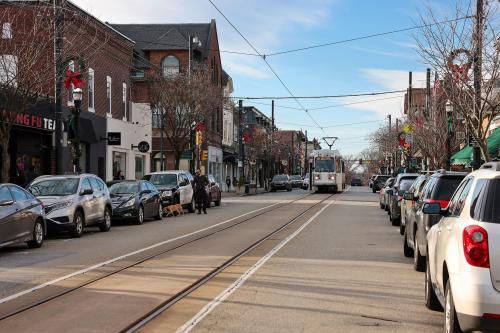Executive Summary
Newark managed over the last decade to halt the serious population decline it endured in the 1980s, according to Census 2000. Nevertheless, the city still confronts a harsh demographic and economic reality at the turn of the 21st century.
During the 1980s, Newark lost one-sixth of its population, the steepest drop in its four decades of population decline. In the 1990s, however, Newark’s population decreased by only half a percentage point. Immigration helped turn the tide. Without its addition of 15,000 foreign-born residents over the 1990s, Newark’s population loss would have continued. At the same time, the characteristics of the city’s households suggest continuing challenges. Newark’s workers must support households that are larger on average than those in any of the other 22 Living Cities. As the city loses married couples and fails to attract coming-of-age singles, a growing proportion of its households are headed by single parents or by other family members such as grandparents.
Newark and its residents also face unique economic challenges. Newark’s adults possess the lowest levels of college education among large U.S. cities, and are unemployed at high rates or absent from the labor force altogether. As a reflection of its low-skill workforce, the city contains only a small fraction of the region’s jobs. As the economic strength of the urban core dissipates, a majority of Newark’s families make do with low-to-moderate incomes, and struggle to pay for housing and the necessities of life.
Along these lines and others, then, Newark in Focus: A Profile from Census 2000 concludes that:
- Newark managed to halt four decades of population decline in the 1990s, but the city no longer anchors the region. Between 1950 and 1990, the City of Newark lost over 160,000 residents, one-third of them in the 1980s alone. Census 2000 revealed that Newark largely stemmed this outflow in the 1990s, as the city’s population declined by only half a percent over the decade. At the same time, the city’s suburbs grew by 7 percent. Today, Newark is a city of just 270,000 in a five-county metro area of over 2 million residents. Only 10 percent of the region’s workers are employed in the central city, and nearly three-fifths of Newark’s own residents commute to jobs outside the city.
- Newark attracted modest numbers of immigrants, stemming continued population loss in the core and the suburbs. Newark lost modest numbers of white and black residents in the 1990s, but added close to 9,000 Hispanic residents. This gain reflects Newark’s addition of 15,000 foreign-born residents in the 1990s, including significant numbers born in South American and Caribbean countries such as Ecuador, Brazil, and the Dominican Republic. As in other metro areas, though, international newcomers to the Newark area are increasingly settling directly in the suburbs; for every immigrant Newark added in the 1990s, its suburbs added seven. Even so, the metro area remains highly stratified along racial and ethnic lines, with African Americans largely confined to the southern half of the city and its western suburbs, and Hispanics confined to the northern half of the city and older suburbs to the north and south.
- Heads of households in Newark, many of them single parents, must support more people on average than in most cities. While 35- to 54-year-old Baby Boomers represent the nation’s largest cohorts, Newark has more 20- to 24-year-olds than any other age group. Newark’s younger age profile reflects the high proportion (20 percent) of city households that are headed by single parents, its continued loss of married couples, and its failure to attract young professionals (aged 25 to 34) over the past decade. Working-age adults in Newark are further burdened by the fact that they must provide for households that are much larger than those in the average Living City.
- Newark residents have low educational attainment, and participate only weakly in the labor market. Little more than half of working-age adults in Newark were employed or looking for work in 2000—the third-lowest percentage among the 100 largest cities in the U.S. As a result, more than one in four Newark children lives in a family with no working parents. These low levels of work may reflect not only a growing distance between inner-city Newark residents and job opportunities elsewhere in the region, but also the low education levels of Newark’s population. Only one in eleven Newark adults holds a college degree, the lowest level among large U.S. cities. Indeed, low rates of educational attainment cut across racial and ethnic lines in Newark, affecting whites, blacks, and Hispanics alike.
- Household incomes in Newark dropped in the 1990s and the middle class shrank. Low- and moderate-income households increased in number in Newark during the 1990s, but the number of middle- and upper-middle-income households (earning $34,000 to $81,000) declined. As a result, the city’s median household income dropped over the decade, and ranked 96th among the 100 largest cities in the U.S. in 2000. In several neighborhoods, more than 40 percent of all residents live in poverty. Forty-five percent of Newark’s families with children have incomes below or near the poverty line.
- Newark’s renters face difficulties in paying for housing and moving toward homeownership. Newark’s low income levels make housing relatively less affordable for families there. Indeed, 42 percent of renter households pay more than 30 percent of their incomes for housing—the fifth-highest share among the 23 Living Cities. These rental burdens limit families’ ability to save for homeownership, and inhibit asset development and appreciation in the inner city. Newark has the lowest homeownership rate among large U.S. cities, and in several city neighborhoods, the elderly represent a majority of homeowners.
By presenting the indicators on the following pages, Newark in Focus: A Profile from Census 2000 seeks to give readers a better sense of where the City of Newark and its residents stand in relation to their peers, and how the 1990s shaped the city, its neighborhoods, and the region. Living Cities and the Brookings Institution Center on Urban and Metropolitan Policy hope that this information will prompt a fruitful dialogue among city and community leaders about the direction Newark should take in the coming decade.
The Brookings Institution is committed to quality, independence, and impact.
We are supported by a diverse array of funders. In line with our values and policies, each Brookings publication represents the sole views of its author(s).


